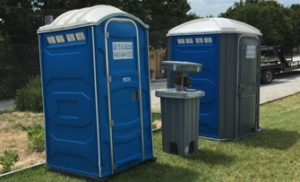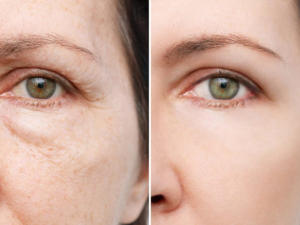Light your way around the campsite and beyond with this rechargeable headlamp that provides powerful hands-free lighting. They also have plenty of extra features that make them a good choice for tradesmen and outdoorsmen alike.

LED technology allows for very bright headlamps that use a small amount of energy. Many are now available with smart features.
Rechargeable headlamps offer the convenience of not having to worry about running out of batteries in a hurry. They’re a smart choice for frequent outdoor users, especially if you plan on spending extended time in the backcountry. They’re also great for camping, working around the house, or running at night.
Most rechargeable headlamps use a lithium-ion battery, and they’re generally cold-resistant. Lithium batteries work better in cold temperatures than alkaline batteries and won’t leak or burst if frozen. Some rechargeable headlamps bundle in a power bank that you can charge up at home for backup, or you can carry regular AA batteries in case of an emergency.
Many of the rechargeable headlamps in our lineup are equipped with a bright LED light with a high lumen rating. But a high lumen count doesn’t necessarily mean a brighter-looking lamp. Other factors, like the brightness of the lens and reflectors, influence how far the beam travels.
Some rechargeable headlamps come with different power modes to manage the battery’s runtime. For example, some feature a floodlight setting that focuses broadly on the area closest to you to conserve battery power and a spotlight mode that shines a tighter focus farther ahead. Some headlamps automatically switch between these two settings based on the environment, while others have a button you can press to manually click through the options.
While most of the rechargeable headlamps in our reviews have a long battery life, you can extend the runtime even further by using lower power modes and by turning off the flashing red light. Using the highest power setting isn’t the best option because it drains the battery quickly.
You can make any headlamp you own rechargeable by replacing the batteries with rechargeables. However, it’s important to note that non-rechargeable batteries don’t drain as fast as rechargeables. They also last longer for extended backcountry trips, and they’re cheaper to replace if you lose them or forget to bring spares.
Brightness
The amount of light emitted from a headlamp is measured in lumens. A higher lumen rating usually means the lamp will appear brighter, but there are other factors that impact brightness. For example, LED placement and lens design can influence the direction in which light is thrown. Also, the type of beam setting (flood or spotlight) can impact how far the light travels. Some headlamps allow users to manually click between these settings, while others have a smart feature that adjusts the lighting depending on ambient light conditions.
Another factor to consider is whether a headlamp has a regulated light mode. Regulated modes maintain a consistent brightness level throughout the life of the batteries, whereas unregulated models fade as they drain. This feature is a must for backcountry hikers, climbers and ultra runners. It reduces stress on the eyes and allows hikers to keep their hands free while navigating difficult terrain.
Some headlamps come with a built-in rechargeable battery pack, while others allow you to use standard AAA batteries. This gives users a backup option in case the rechargeable battery dies or the headlamp is accidentally turned on while in storage. Some headlamps even offer a holder for an extra lithium battery to provide additional run time.
Whether you’re a crafter, sculptor or designer, you need a quality source of lighting to illuminate your work space. Rechargeable headlamps are a versatile lighting solution for a variety of creative applications. The convenience and portability of headlamps make them an ideal choice for craftsmen who need a hands-free light source while they work on projects.
Headlamps with red light settings are also popular among outdoorsy people who want to preserve their night vision while hiking, camping and star gazing. Some people also find that they can read in their tent or around the campfire more easily with a dim red light. Additionally, some birders prefer to use headlamps with red light to avoid scaring migratory birds.
Controls
Almost all modern headlamps use LEDs (light-emitting diodes), which have the power to produce a lot of light for a small amount of energy. However, not all LEDs are created equal.
A lot of consumers think that a high lumen rating automatically means a brighter headlamp, but it’s not true. Other factors influence brightness, including the beam distance and type. For instance, some lights may have a floodlight mode that spreads the illumination far and wide for general lighting, while others might use a spotlight mode that focuses a tighter beam on your immediate path ahead.
It’s also important to consider how easily the headlamp can be operated with gloves on. Some manufacturers offer a glove-friendly control system where you can operate the buttons by pressing them with your thumb. This can be especially useful for people who wear gloves for work or for outdoor enthusiasts that want to be able to switch modes and change batteries without having to take off their gloves.
Lastly, it’s important to choose a headlamp with comfortable strap adjustments. Some lamps will have a strap that adjusts to fit around the back of your head, while others will have a band that goes around the front of your forehead. The strap should be durable and made of a breathable material that will keep you cool and comfortable.
Many of the top rechargeable headlamps on the market today come with a cold-resistant lithium-ion battery that will keep you illuminated for hours at a time. Some of them also feature the option to be powered by old-school AAA batteries, which can be helpful if you don’t have a spare battery or if yours dies while you’re out on an adventure.
Other features to look for in a headlamp include preset lighting profiles that help tailor the illumination to your specific activity, a lock to prevent accidental powering on and draining while in a pack, a red backlight for visibility, and a battery meter. The NEBO EINSTEIN Series is a great example of a rechargeable headlamp that offers all of these options in a compact and versatile package.
Weight
Compared to traditional battery-powered flashlights, rechargeable headlamps pack more power in a smaller package. This reduces the overall weight of the lamp and also leaves your hands free to focus on climbing, crawling or hauling gear. Some lights feature a battery pack on the back of the band which distributes the weight more evenly, which is important for comfort while wearing the light for extended periods of time.
The best rechargeable headlamps are lightweight, comfortable, and easy to adjust to fit the shape of your head. Some have strap adjustments that allow you to secure the headlamp snugly, without putting too much pressure on your forehead. Others offer a flexible strap which helps to cushion the impact when you bump into things while moving forward.
Rechargeable headlamps are also more environmentally conscious than traditional battery-powered models. The built-in batteries in these lights can be recharged several times over the life of the headlamp, reducing waste and the number of disposable batteries that need to be disposed of.
Some rechargeable headlamps have a battery-life indicator which lets you know when the batteries are starting to run low. This can help you plan ahead and make sure you have a bright enough light for the rest of your trip, or that you have extra batteries in case you need them.
Another important aspect of a rechargeable headlamp is how waterproof it is. This is especially true for outdoor enthusiasts who may be hiking, camping, or kayaking on a dark, rainy night. If you’re using your rechargeable headlamp outdoors, be sure to check the seals on the battery compartment and other components regularly for cracks or wear. Replace worn seals promptly to ensure a water-resistant headlamp that stays protected in harsh conditions.
Rechargeable headlamps are a great addition to any backpacker’s kit. They’re convenient, affordable, and versatile, making them a must-have for any outdoor adventurer. They’re available in multiple wattages and features, so you can find the perfect one to suit your needs. With a variety of charging options, you can easily charge your rechargeable headlamp wherever you go, so you’ll never be caught off guard by the darkness again.








